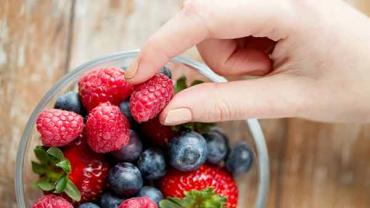
Berries have a lot going for them. They’re colorful, sweet, delicious, and they’re like the people we envy who are comfortable in all different kinds of social circles—Paleo, low-carb, keto, vegetarian, vegan, Mediterranean. It’s hard to think of a dietary approach that doesn’t include berries, even if they need to be consumed in smaller quantities, such as on a ketogenic diet. Beyond just being flavorful, berries have several properties that make them worth including in the diet. Nature must’ve known what it was doing by making these little gems so eye-catching and enticing.
Whether someone’s diet consists primarily of animal foods or primarily plant foods, most people are aware of the need to keep sugar consumption low. Berries are a great way to get a sweet fix for surprisingly low total sugar. The table below provides select information on popular berries (per 100 gram serving; percentages are % daily value), but keep in mind that this is a general ballpark. The type of berry cultivar, different growing conditions, and handling conditions during transport or storage can affect nutrient content.
|
|
Calories |
Total carbs |
Fiber |
Glucose |
Fructose |
Vit. C |
Vit. K |
Manganese |
|
32 |
7.7 g |
2.0 g |
1990 mg |
2440 mg |
98% |
3% |
19% |
|
|
57 |
14.5 g |
2.4 g |
4880 mg |
4970 mg |
16% |
24% |
17% |
|
|
43 |
10.2 g |
5.3 g |
2310 mg |
2400 mg |
35% |
25% |
32% |
|
|
52 |
11.9 g |
6.5 g |
1860 mg |
2350 mg |
44% |
10% |
34% |
As you can see, berries are very low in total sugar, and when you subtract the fiber, the “net carb” amount is even lower. For those concerned about the specific effects of fructose, berries are among the lowest fructose fruits.
The anthocyanins behind the red, blue and purple pigments of berries (as well as plums, eggplant, red wine and more) do more than lend color. They’ve been shown to inhibit starch-digesting enzymes in the small intestine (α-amylase and α-glucosidase), potentially being of benefit for reducing postprandial glycemic excursions in those with type 2 diabetes and others with difficulty controlling post-meal blood glucose. Anthocyanins inhibit α-glucosidase and ellagitannins inhibit α-amylase. Researchers note, “there is potential for synergistic effects on starch degradation after ingestion of berries such as raspberries and strawberries,” which are high in both anthocyanins and ellagitannins. However, various berry polyphenols may also inhibit protease activity, so the desired effect of reducing postprandial glucose excursions after a meal containing starch would have to be balanced against the potential for the undesirable effect of interfering with protein digestion.
Not all berries inhibit starch-digesting enzymes to the same extent. Strawberry and raspberry extracts inhibit α-amylase more than blueberry or blackcurrant, while conversely, α-glucosidase was more strongly inhibited by blueberry and blackcurrant extracts. Researchers determined that anthocyanin content is a major determinant of α-glucosidase inhibition, which explains why blueberry and blackcurrant, which have the highest anthocyanin content, are the most potent inhibitors of this enzyme. Tannins appear more effective for inhibiting α-amylase, and strawberries and raspberries are higher in tannins. Other tannin-rich extracts, such as from red grapes and wine, and green tea, also effectively inhibit α-amylase. Perhaps there’s something scientific and not merely cultural behind Italians drinking red wine with bread and pasta dishes, and East Asians consuming green tea with meals containing rice: these particular pairings likely reduce the glycemic and insulinogenic impact of these starchy foods. Most likely it’s just a happy accident, but maybe not; maybe science now has a solid explanation for something that was done as a matter of course.
Other research suggests that compounds other than anthocyanins may be responsible for inhibiting starch degrading enzymes, because extracts from yellow and red raspberries were equally effective in inhibiting α-amylase, and yellow raspberry extracts are virtually free of anthocyanins. Also, extract from rowanberries, which have low anthocyanin content but are high in chlorogenic acid, is also effective for α-amylase inhibition. Whether it’s anthocyanins, tannins, chlorogenic acid, or some as-yet-unknown factor, blackcurrant and rowanberry extracts may be effective enough to replace the drug acarbose, or at least reduce the dose needed.
These interesting effects of berries on starch degrading enzymes may partly underlie the recognition that whole fruits appear to be relatively benign for those with diabetes, and why diets high in vegetables and fruits are associated with lower risk for type 2 diabetes.
Moving on to a separate effect of berries (besides tasting wonderful with cream or coconut milk, that is), ellagic acid and ellagitannins in strawberries, blackberries and raspberries show antimicrobial activity against fungi, viruses and bacteria, including antibiotic-resistant strains such MRSA. Ellagic acid and ellagitannins from berries are being explored for anticancer effects, including induction of apoptosis as well as antiproliferative activity.
Farmers’ markets will be in full swing in most of North America in just a few months. So, look for berries, and try to buy locally and seasonally. Berries in season are sweeter and more flavorful, although frozen berries are a great choice too, since they’re frozen at peak ripeness, and that way you can enjoy them all year long. (Or buy fresh and freeze them yourself.) Read more about specific berries in these DFH articles on blackberries, raspberries and bilberries.